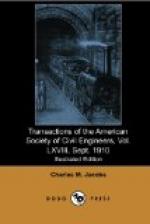Investigations, made during the progress of the work to determine the physical character of the silt and its action on the tunnels, suggested the possibility that the use of pile supports might be inadvisable. This view was confirmed by actual experience in the operation of the tunnels of the Hudson Companies between Hoboken, N. J., and Morton Street, Manhattan, which were opened to traffic in February, 1908. The stability of these tunnels under traffic gave further assurance that supports were unnecessary under the North River tunnels of the Pennsylvania Railroad Company, and they were therefore dispensed with.
Cross-Passages Between the Tunnels.—The Bergen Hill tunnels, the land portions of the North River tunnels and the tunnels under Manhattan are connected by cross-passages at intervals varying from 50 to 300 ft. As it was the desire of the Management to provide every arrangement possible to insure the safety of its passengers and employees and also to provide for the convenience of inspection, the question of establishing cross-passages between the tunnels under the rivers was given most careful consideration. The conclusion was finally reached that such passages as it was possible to construct between these tunnels might increase instead of diminish the danger in case of accident. No more cross-passages have therefore been constructed in the sub-river sections, except in the East River, where there is a cross-passage and pump chamber combined between each pair of tunnels about 750 ft. from the Manhattan bulkhead line.
PROBABLE RESULTS OF THE IMPROVEMENTS.
In preceding pages reference has been made to the general objects of the improvements included in the project of the Pennsylvania Railroad Company for the New York District. While it is impossible, in this introductory paper, to analyze fully the transportation problem at New York, it seems desirable to indicate briefly some of the more obvious effects which the improvements may be expected to produce upon the distribution and handling of traffic.
New York City owes its position as the business metropolis of the country mainly to its magnificent harbor and the extensive waterfronts on its deep, wide rivers, which furnish unrivaled facilities, at a short distance from the sea, for foreign and domestic water-borne commerce, its foreign commerce being about half the total for the whole country. The water-transportation facilities of the port and its tributaries, therefore, have always been guarded with jealous care, not only by the local commercial interests but also by the General Government.




